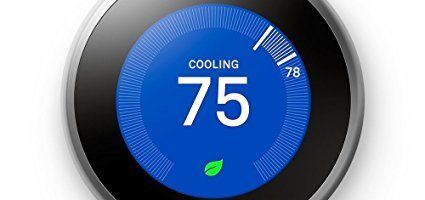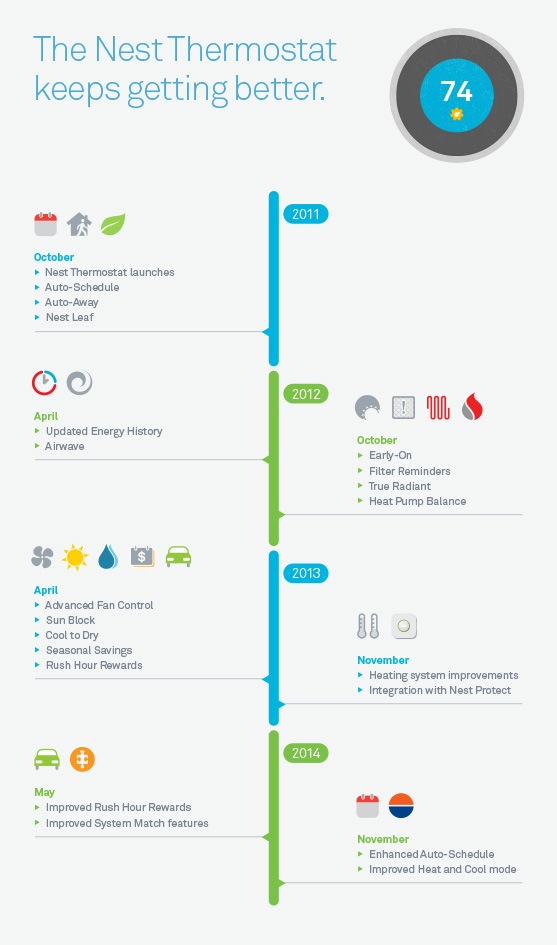IoT and Me: Nest, Machine Learning, and the Smart Device Revolution

Nest, a market leader in the smart devices space, employs machine learning and big data to cater to its customers, push its products forward, and explore new areas of innovation.
As connected smart homes and the Internet of Things continue to become more mainstream, Nest is one of the companies at the forefront of this revolution. From its flagship smart thermostat to security cameras and smoke alarms, Nest employs complex machine learning algorithms to save consumers energy, keep their homes safe, and harness the power of big data.
Due to recent technological advancements and consumer interest in connected devices, the smart home market is rapidly expanding, with an estimated 31% CAGR [1] and estimated market size of $45B [2]. With the plethora of products available in the space, smart device firms need to distinguish their products from those of their competitors and push the boundaries of product development to create novel products that can disrupt the market. Nest has been doing this since introducing their smart thermostat in 2011, with expansions into smart security cameras, doorbells, and smoke alarms. Nest devices can be controlled from customers’ phones and dynamically learn customers’ preferences over time. They take in various inputs such as temperature adjustments, home inhabitant schedules, and weather to optimize thermostat settings and detect anomalies in home occupancy. The devices can also recognize customer patterns to differentiate between weekends vs. weekdays and time at work vs. home [3]. According to Nest’s analysis, its thermostat can cut heating and cooling bills by 10-15% through machine learning and smart schedules. These energy savings are worth between $131-$145 annually, meaning that the $249 thermostat pays itself off in under 2 years [4]. In addition, Nest’s devices have been critical in identifying burglaries and carbon monoxide emergencies. By building a solid, satisfied customer base, Nest can push more of its connected home products to those customers and encourage them to purchase other items that can integrate with Nest, such as Google Home. The company can also use its wealth of data to continually iterate on its products and make them more tailored for customer use.
However, despite Nest’s success and parent company Google’s substantial investment in R&D, both companies are still trying to catch up to smart device market leader Amazon and fight off competitors like Honeywell. To do so, Google and Nest have made considerable investments into new product lines and partnerships. In fact, Nest experienced a large net operating loss of $621M in 2017, much of which is likely attributable to its expanded product portfolio [5]. The company recently introduced 2 new product lines: home security system Nest Secure in late 2017 [6] and doorbell Nest Hello in early 2018 [7]. In addition, the company partnered with Whirlpool and GE on integrating Nest technology into Whirlpool [8] and GE appliances [9]. It also is working closely with Google on expanded product offerings with Google Home and Google Assistant. For longer-term goals, not only is Nest doing its own R&D, but it also recognizes that working with Amazon can be beneficial, both from brand awareness and competitive standpoints [10]. By doing so, Nest and Google can chip away at Amazon’s dominant position in the market and make their products stickier with consumers. Another key factor to consider is that Nest rejoined Google earlier in 2018, rolling into the hardware division. After a couple months there, Nest then merged with Google Home, allowing both entities to fully take advantage of each other’s expertise and resources [11].
In addition to Nest’s plan moving forward, there are ample opportunities for the firm to establish itself as a smart device market leader through machine learning and product innovations. Business Insider believes the market is currently “stuck in the ‘chasm’ of the technology adoption curve,” [12] but Matt Rogers, one of Nest’s co-founders, sees Nest emerging out of the trough of the product development “Hype Cycle” [13]. To ensure the company is progressing in the right direction, Nest should utilize Google’s vast resources and focus on expanding its product offerings into additional connected home devices, such as light switches, power strips, and window blinds. It should also continue to analyze its data to glean insights on customer behavior to refine its machine learning algorithms. Nest should emphasize integrating with wearables and vehicles as well, especially as almost half the people in the connected home market own wearables [14] and as the autonomous vehicle market grows at 36.2% CAGR [15]. Nest should also work on a singular connected platform for all its products, giving it a huge competitive edge by tackling the long-standing issue of a highly fragmented smart device market without clean integration across devices [16].
Nest has clearly established itself as a market leader in the smart devices space, but the company still faces stiff competition and consumer skepticism. What product and partnership areas should Nest focus on? How can the company appeal to its expansive consumer base, which potentially includes all homeowners, renters, and landlords?
(799 words)
[1] Ahuja, Kabir and Patel, Mark. “There’s No Place Like [A Connected] Home.” McKinsey, 2016. https://www.mckinsey.com/spContent/connected_homes/index.html, accessed November 2018.
[2] Reuters. “Global Smart Homes Market 2018 by Evolving Technology, Projections & Estimations, Business Competitors, Cost Structure, Key Companies and Forecast to 2023.” Reuters, February 19, 2018. https://www.reuters.com/brandfeatures/venture-capital/article?id=28096, accessed November 2018.
[3] Nest. “How Nest thermostats learn.” https://nest.com/support/article/An-introduction-to-learning, accessed November 2018.
[4] Rogers, Matt. “The Nest Learning Thermostat saves energy. Here’s the proof.” Nest, February 12, 2015. https://nest.com/blog/2015/02/02/the-nest-learning-thermostat-saves-energy-heres-the-proof/, accessed November 2018.
[5] Niu, Evan. “Alphabet Discloses Nest Financials for the First Time.” The Motley Fool, April 24, 2018. https://www.fool.com/investing/2018/04/24/alphabet-discloses-nest-financials-for-the-first-t.aspx, accessed November 2018.
[6] Weinberger, Matt. “Nest just announced a full-fledged home-security system for $499.” Business Insider, September 20, 2017. https://www.businessinsider.com/nest-secure-home-security-system-costs-499-will-compete-with-adt-comcast-2017-9?op=1, accessed November 2018.
[7] Brown, Rich. “Nest says Hello with a new doorbell camera.” CNET, September 20, 2017. https://www.cnet.com/news/nest-says-hello-with-a-new-doorbell-camera/, accessed November 2018.
[8] Whirlpool. “Connected Appliances.” https://www.whirlpool.com/home-innovations/connected-appliances.html, accessed November 2018.
[9] General Electric. “GE WiFi Connect.” https://www.geappliances.com/ge/connected-appliances/, accessed November 2018.
[10] Nest. “Learn how to control your Nest products with Amazon Alexa.” https://nest.com/support/article/Nest-and-Amazon-Alexa, accessed November 2018.
[11] Osterloh, Rick and Fawaz, Marwan. “Nest to join forces with Google’s hardware team.” Google, February 7, 2018. https://blog.google/inside-google/company-announcements/nest-join-forces-googles-hardware-team/, accessed November 2018.
[12] Business Insider Intelligence. “Nest looks to enhance AI and machine learning.” Business Insider, January 25, 2017. https://www.businessinsider.com/nest-looks-to-enhance-ai-machine-learning-2017-1, accessed November 2018.
[13] Bradshaw, Tim. “Nest looks to the cloud to boost machine learning capability.” Financial Times, March 10, 2016. https://www.ft.com/content/bb99c4cc-e673-11e5-ac45-5c039e797d1c, accessed November 2018.
[14] Ahuja, Kabir and Patel, Mark. “There’s No Place Like [A Connected] Home.” McKinsey, 2016. https://www.mckinsey.com/spContent/connected_homes/index.html, accessed November 2018.
[15] Market Watch. “Self-driving Car Market to Grow at a CAGR of 36.2%, leading to global revenue of USD 173.15 Bn by 2023.” Market Watch, September 11, 2018. https://www.marketwatch.com/press-release/self-driving-car-market-to-grow-at-a-cagr-of-362-leading-to-global-revenue-of-usd-17315-bn-by-2023-2018-09-11, accessed November 2018.
[16] Ahuja, Kabir and Patel, Mark. “There’s No Place Like [A Connected] Home.” McKinsey, 2016. https://www.mckinsey.com/spContent/connected_homes/index.html, accessed November 2018.




I think your suggestion of integrating the various ‘smart’ devices into a single platform is a critical component of the answer to your question regarding appealing to the mass market. With so many devices that require different apps, chargers, etc. it is easy for consumers to feel overwhelmed by this market. By allowing consumers to control their ‘smart home’ all in one app, I think Nest is much more likely to see higher adoption rates.